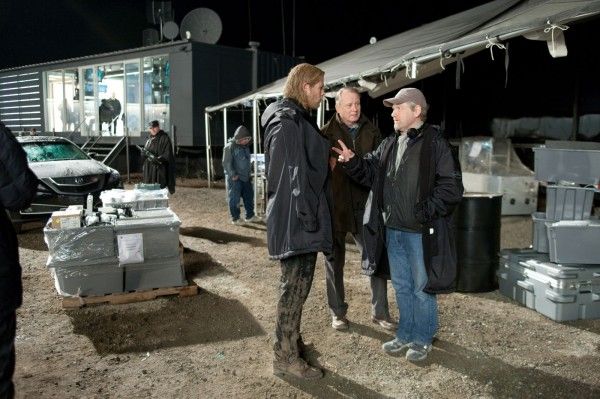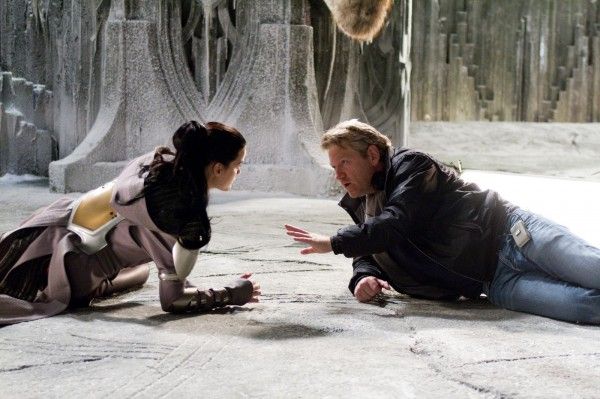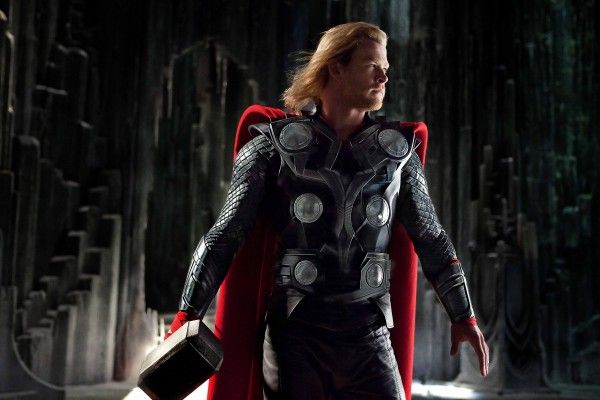I have to admit, up until I went to the screening of Thor, all I knew about the Marvel character was what I learned from watching Adventures in Babysitting as a kid. So, I went into the film hoping to be as intrigued and compelled by Chris Hemsworth’s Thor as I was in watching Robert Downey Jr. as Iron Man, who I also knew nothing about prior to seeing that first film. I quickly found myself sold on the Aussie actor’s performance and was along for the ride while Thor went on a mythic journey from being the arrogant prince of Asgard to a humble superhero who deserves the power that he was born to inherit. And, although Thor is more of a coming-to-power story than an origin story, I find myself actually excited about seeing the Marvel characters team up for The Avengers, slated for release in 2012.
At the film’s press day, director Kenneth Branagh and Marvel Studios President Kevin Feige talked about how finding the right Thor was the most important aspect of the film, the challenge in making a film as big in scale as Thor, how passionate and intense this family story is, what makes Thor a cool character, and the possibility of a sequel. Check out what they had to say after the jump.
The epic adventure Thor spans the Marvel Universe from present day Earth to the mystical realm of Asgard. At the center of the story is The Mighty Thor (Chris Hemsworth), a powerful but arrogant warrior whose reckless actions reignite an ancient war. As a result, Thor is banished to Earth, where he is forced to live among humans. When the most dangerous villain of his world sends its darkest forces to invade Earth, Thor learns what it takes to be a true hero.
Kenneth, when it was announced that you would be directing Thor, there was some discussion that you weren’t an obvious choice. During filming, did you ever feel that way?
KENNETH BRANAGH: The scale of the undertaking couldn’t help but occasionally make you feel that. It was very, very challenging, but that was part of what was attractive. People have sometimes asked me, “How did you do it?,” and I say, “Have you seen the credits at the end? There’s seven minutes of them. Did you see all of those names? That’s how I did it.” I was surrounded by people who were crucial to it. And frankly, when you walked in on day one and there were Frost Giants, green screen, real mist and rain, six principals in their new costumes for the first time, four camera crews and hundreds of people, you go to the people you’re working with and say, “What do I do next?” On day one, in Kevin Feige’s office in Beverly Hills, I said, “What should I do first? Should I go to visual effects? Should I go to 3D? Are there places I don’t know?” And, Kevin said, “The one thing you need to do right now, and until it’s finished, is cast Thor. That’s it. Just cast Thor.” So, we did.
Because this is the first story for this character, did that give you more creative freedom in establishing the character?
BRANAGH: Absolutely. Kevin and the rest of my colleagues at Marvel were completely and invisibly the architects of the larger universe. I always felt, whether it was simply because that’s all I was capable of, that Thor and Thor for one film was all I had to do. That was enough. It was about, “How do you introduce this character?” And then, the process by which it may effect other things was smooth. As a viewer, I am intrigued by the interweaving of the way things happen in the Marvel Universe. I was excited when the opportunities to relate to that, in some way, were there, but it’s essentially a collaboration and partnership.
What is the most challenging thing about taking a story like this from comic book to big screen?
BRANAGH: It’s the scale thing that is tricky.
KEVIN FEIGE: All of the characters have their own challenges, of course. Thor is a particular challenge because he’s from another world. We don’t have a Superman type character from another world. In terms of the primary characters that we have, Thor is unique, in that regard. He also is unique in that he is based, in part, on Norse mythology. You have a big melting pot of a lot of different ideas, which Stan Lee and Jack Kirby put together into our great mythology, 45 plus years ago, and we’re 600 plus issues into it now. We sat with 600 issues and said, “What story do we tell?,” and frankly, the writers had a big challenge. We’ve been working on the movie for many years, and there were a lot of different incarnations. It was sort of trial and error, but figuring out that we were going to introduce a story that starts on Earth in present day, throw the viewer into these other worlds, and then bring them back to Earth, so we have a little bit of an idea of where Thor is from and why he’s reacting the way he is was probably structurally the biggest challenge.
Kenneth, did your experience with other effects movies, like Harry Potter, as an actor make you more comfortable in dealing with so many effects as a director?
BRANAGH: Yes, but the quality of the technology changes and the advances in the technology change so much that it’s advancing on a daily basis. I did the Harry Potter film quite some time ago, and as brilliant as they are, Marvel is on the cutting edge of things, I’m pleased to say. The whole of the process, from day one through to the end, was an expanding possibility with visual effects. There was a bit of preparation, but frankly there are new opportunities every day.
Did all of your past work with Shakespeare help you in developing this family dynamic?
BRANAGH: We’ve just seen about two billion people watch a royal family at work, so I would say that it is Shakespearean, but it’s global that we’re interested in what goes on in the corridors of power, whether it’s the White House or Buckingham Palace. Shakespeare was interested in the lives of medieval royal families, but he also raided the Roman myths and the Greek myths for the same purpose. I think Stan Lee went to the myths that Shakespeare hadn’t used, all of them recognizing that they contained briefly told, very condensed stories of that are very universal in their application. I think the connection, if there is one, is that the stakes are high. So, in something like Henry IV or Henry V, where you’re wondering if that young prince could be the king and whether he’s the right man for the job. That story arc of the flawed hero who must earn the right to be king is in our piece, but what’s key is the stakes. There, it’s Europe and England, and here, it’s the universe. When that family has problems, everybody else is affected. If Thor throws a fit and is yelling at his father and is banished, suddenly the worlds are unstable. What that means is that, if the actors take those stakes seriously, it is passionate and very intense. That observation of ordinary human – although they’re gods – frailties in people in positions of power is an obsession of great storytellers, including Shakespeare and including the Marvel Universe.
What was the process in casting for the role of Thor, and what was the relationship between Anthony Hopkins and Chris Hemsworth like on set?
BRANAGH: Finding the character arc for Thor was key, and we were doing that all the way through the early process of finding Thor. It’s true to say that Chris Hemsworth came in early on, and we weren’t fully on the page with what we were developing for it. We weren’t as clear. We became pretty ambitious with what was clearly going to be a character journey of somebody who definitely changed from the beginning of the movie to the end. The more we realized that, the more we realized that it wouldn’t only rely on braun, but it would need some acting brains, some emotion and some fun. The character could take it, and the story seemed to want it, so we were really looking for a lot tied up in one bundle. At some point, we said, “Well, we should go back and meet that very handsome Australian lad, who came in when our story wasn’t really on the page.” When he came back and he read, did some workshops, and read with actors and actresses. And then, he told a story of Thor’s deeds, like a warrior re-telling a story of a great battle, and the mixture of an arrogance that he needed to have still was done with such charm that he nailed it. It meant that when he got on set with Tony Hopkins, there was this additional required quality of an innate, charming confidence that did not spill over into arrogance or over-confidence. It meant that he would stand up in a scene with Tony Hopkins. As the Prince of Asgard, he couldn’t shy away from it. It was really a privilege to see how he embodied all of that. And then, ultimately of course, when he takes his shirt off, there’s also a wow factor that cannot be denied. When we were finishing up the film a few weeks ago, Louis D’Esposito, co-President of Marvel, said, “My god, he looks good in 3D!”
What was it about Thor that you thought made him a cool guy, when you first discovered him in the comics?
BRANAGH: For me, it was the primitive quality. I liked his wild quality. I liked the Viking at the center of it. That’s what I saw, when I saw those images on a comic book. He was volatile, and I thought that would be dangerous in telling a movie. He’s not too smooth and he’s not too slick. One of the things that we were trying to achieve in the telling of the story was that it could feel in the moment, and there could be genuine danger.
FEIGE: I liked Thor. I grew up with the character, as I did with all the Marvel characters, but I was particularly excited about it, coming off of being part of the Spider-Man films, the X-Men films, the Hulk films and, more recently, the Iron Man films. I wanted to expand the notion of a Marvel movie. I like the idea of going to outer space and going to more of a sci-fi sandbox, which is frankly why we didn’t shy away from big, giant, gleaming cities in outer space, on other planets. The Bifrost travel, with Heimdall (Idris Elba) standing in the center, was always a part of the mythology, in every comic book, but the way Ken [Branagh] envisioned it in this film has much more of a sci-fi edge, which I always wanted to be a part of and am very proud that we pulled it off in a way that all audiences – whether they have read comics or haven’t read comics, or like science fiction or don’t like science fiction – can respond to and relate to.
Can you talk about casting Tom Hiddleston for Loki?
BRANAGH: From the performance point of view, we needed somebody who was complex and could convey intelligence. There was a constant conversation between us all about whether it was a good thing to keep the question mark over the character of Loki throughout. Is he bad? Does he have a plan? Does he love his brother? Does he hate his brother? Does he hate his father? Is this happening before our very eyes? How does he truly react to the secrets and lies that emerge, in the course of the story? So, you needed someone who could be adept at putting on all those masks and making it seem seamless. That level of shocking skill. in an actor in life, was what we were after from the performance. I had worked with Tom in England and the U.K. on television and in theater and knew that he was energized, bright and quick thinking. That’s what we wanted from the performance.
FEIGE: The movie, very much, is an origin of Loki, almost as much as it is an origin of Thor. We had to ride that balance. There were drafts where Thor took over too much, and there were certainly drafts where Loki became too prominent, and I think we found a nice balance that is clearly the origin of both of those characters. Tom is a great actor, there’s no doubt about it, but make no mistake that Tom, like Loki, wanted to be Thor. He was up for it. He actually auditioned for Thor. He gained all sorts of weight and did his audition and we went, “You’re Loki.” There’s a piece of behind-the-scenes B-roll online that will definitely be on the DVD, where Tom and Chris are in our big Asgardian ceremony set, in their full costumes, and Chris is holding his hammer, and Tom just comes by and says, “Let me hold that, for a minute.” You see Tom, dressed as Loki, holding and swinging the hammer around, and Chris was like, “Hey, give me that back.” There is such a glee on his face too, as he’s holding it. It’s a great clip. It’s very telling.
Aside from The Avengers, will audiences see Thor in his own sequel?
FEIGE: Well, we’ve got 600 plus issues and a thousand years of mythology. We have other stories we’d like to tell. The audience will tell us whether they want to see those other stories, but we have to be prepared for that, if we should get the call. So, (screenwriter) Don Payne is working on story ideas for a Part 2. We’ve got various options with Ken [Branagh], to discuss coming back. Right now, the focus is on the first film, but Don is slowly but surely thinking about where to take the character next, should we be so lucky.
BRANAGH: Kevin and I share, from our point of view, a deep Irish Celtic superstition of taking anything for granted, and the Marvel world is a world of non-assumption. When I first started in the film business – and please forgive the language I’m about to use – a producer said to me, “Young man, assumption is the mother of all fuck-ups.” So, we are assuming nothing. We are offering the film out to the world and we shall listen. That’s what will happen.
Kenneth, do you already have a project lined up to work on next?
BRANAGH: I’ll be walking the dog. Truly, that’s my next project.



